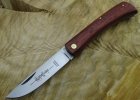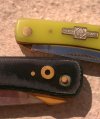Bird Eye: Pin and washers, pin peened. Can fail (see post number 8, by
 Jolipapa
Jolipapa
)
Cutlery Rivets: Large Shoulders, like a Corby Bolt/Chicago Screw, but not threaded. Slightly over-size diameter tapered post, may or may not have a knurled or ringed/barbed post. Permanently pressed together.
Corby Bolts/Chicago Screws: Large heads, threaded post. Can be disassembled. (unless assembled using red locktite or an excess of blue locktite.)
For a liner-less knife like the Sod Buster pattern. In my
opinion the Cutlery Rivet and Corby Bolt/Chicago Screw would be the stronger, simply because of greater internal contact area compared to the contact area of a peened pin.
The rivets on an Old Hickory and Russell Green River with wood handle slabs are cutlery rivets. (how many old/ancient/antique Old Hickory or Russell Green River butcher knives, or "Buffalo Skinner" knives, for example, have you seen or heard of, that is missing a handle rivet?)
My apologies, but I currently don't have any unused cutler rivets to take a photo of, with me.

I do have some un-used Corby Bolts/Chicago Screws, however.

Cutlery rivets look the same but have a slightly over-size diameter tapered non-threaded post (that may or may not be knurled or ringed/barbed) and tapered hole, and no screw slot on either part.
View attachment 1470666










